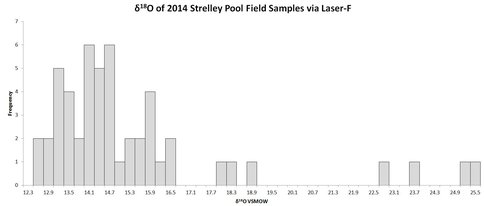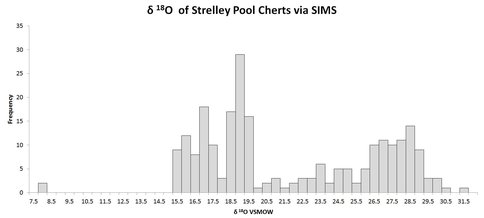2014 Annual Science Report
 University of Wisconsin
Reporting | SEP 2013 – DEC 2014
University of Wisconsin
Reporting | SEP 2013 – DEC 2014
Project 3B: Genesis of High-δ18O Archean Chert, Pilbara Craton, Australia
Project Summary
This investigation centers on the 3.43 – 3.35 Ga Strelley Pool Formation in the Pilbara craton of western Australia, which harbors some of the oldest convincing evidence for life. The research has three major components – 1) detection and characterization of habitable Paleoarchean environments to apply to the search for life-bearing extraterrestrial environments; 2) creating an isotopic guide to the sedimentary environments and relative timing and origin of these formation’s textures; 3) constrain paleoenvironmental evidence for the putative stromatolitic microfossils in the region. We are comparing conventional bulk analytical techniques vs. SIMS in-situ microanalysis to unravel the δ18O and δ13C isotopic and geochemical variation of the micro-textural, and generational quartz, dolomite, ankerite, and calcite varieties in these stromatolitic rocks. Understanding paleoenvironments supporting ancient biospheres aids in the understanding of the necessary conditions for life’s persistence, providing further basis for locating and identifying extraterrestrial life.
Project Progress
Oxygen isotope ratios have been measured in quartz from the Strelley Pool chert, N. Pole Dome, Pilbara craton using both conventional laser-fluorination techniques at 1-mm scale and in situ SIMS analysis of 10-μm diameter spots.
Oxygen isotope ratios for all samples in outcrop vary from 12.5 to 25.5 ‰ VSMOW (Fig. 1). The values of 22.5 to 25.5 are the highest reported for cherts at 3.4 Ga and are associated with stromatolites of the Trendall locality that formed in a shallow water environment. These cherts appear pristine in hand sample and come from an outcrop where the Shaw River has cut deeply into the ridge of Strelley Pool chert; it was hoped that the effects of weathering would be minimized at this locality. If δ18O(Qt) is interpreted for thermometry of the Archean ocean, such high values indicate lower temperatures than previous reports. Two tests were applied to evaluate these high values: 1) analysis of samples in drill core that would be less affected by near-surface weathering and alteration, and 2) in situ imaging and analysis to evaluate variability within a hand sample and to test if different generations of quartz are present.
Figure 2 shows conventional 1-mm scale data for δ18O(Qt) from Strelley Pool chert in drill core from the ABDP8 hole. The ABDP8 core was sampled by Valley and Cammack at the GSWA core library in Perth, Australia in June 2014. Values range from 9.5 to 15 ‰ and the higher values seen in outcrop are missing. These results suggest either that the high δ18O values are unique to stromatolitic horizons that are not seen in ABDP8, or that the high values formed by last near-surface weathering and alteration.
Figure 3 shows all values measured in situ by SIMS, regardless of textures. Several generations of quartz are seen optically and by SEM. Many SIMS analyses of mega-quartz are in the range 25 to 31 ‰, higher than seen in previous studies of Archean quartz. The mm-scale data in Fig. 1 represent averages of these data and thus the conventional analyses are proven to have no useful meaning for geological interpretation. Fig. 4 shows an optical image in transmitted light with cross-polaroid filters. Two prominent generations of quartz are seen: micro-quartz (<10 μm dia) and mega-quartz (>25 μm dia). The upper inset image (SEM-SE) shows the SIMS pits and the lower inset image shows mega-quartz with euhedral crystal facies growing into open cavities. Two such cavities are seen adjacent to mega-quartz along the right- and left-borders of the optical and upper-inset images. Values of δ18O are coded by letters to the optical image.
Micro-quartz δ18O values in Figure 4 range from 17.9 to 18.5, while mega-quartz values are 26.3 to 29.5. These textural relations prove that the high δ18O generation of mega-quartz in these rocks formed later than the microquartz.
Taken together, we interpret these results to suggest that the high δ18O values measured by SIMS in mega-quartz and at mm-scale by conventional analysis formed during lateritic weathering in outcrop samples. This conclusion is supported by the absence of high values in core from ABDP8. Furthermore, high values of δ18O(Qt) near 30‰ were also measured in drusy brecciated quartz from the top of the ridge near Trendall locality. Such clearly altered material is not found at river level, but apparently the effects of weathering are still present, at a lower, harder-to-recognize level.
Unfortunately, these results don’t resolve the 40-year controversy over why Archean cherts are systematically lower in δ18O than in younger rocks. In addition to the three common hypotheses: 1. More alteration in Archean samples, 2. hotter oceans in the Archean, or 3. lower δ18O oceans in the Archean; we point out that the microquartz is not a primary precipitate from seawater. It is equally likely that the processes of diagenesis were different in the Archean due to changes in the compositions of the oceans and atmosphere. We are continuing to search for earlier components in these rocks, including carbonates. The combination of microscopy and in situ stable isotope analysis is in its infancy for Archean cherts. There is much still to learn.
-
PROJECT INVESTIGATORS:
-
PROJECT MEMBERS:
John Valley
Project Investigator
Jake Cammack
Collaborator
Noriko Kita
Collaborator
Kouki Kitajima
Collaborator
Reinhard Kozdon
Collaborator
Mike Spicuzza
Collaborator
Martin Van Kranendonk
Collaborator
-
RELATED OBJECTIVES:
Objective 4.1
Earth's early biosphere.
Objective 7.2
Biosignatures to be sought in nearby planetary systems



